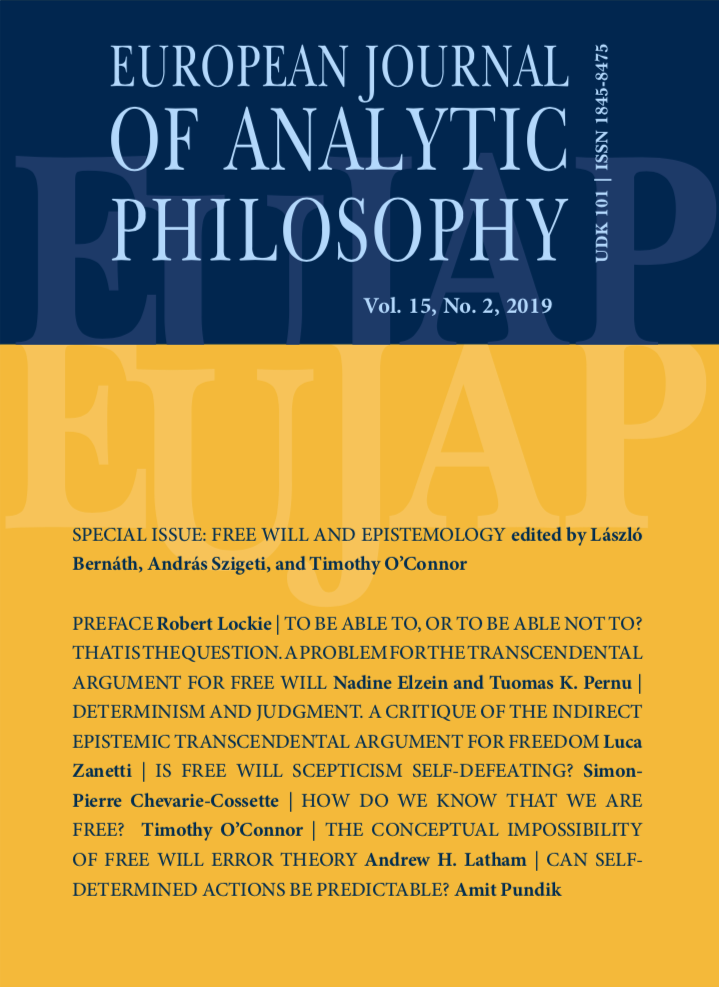View the whole issue here
- Quine’s Poor Tom
Tristan Grøtvedt HazePages: 5-16 | Abstract | 10.31820/ejap.15.1.1
Section 31 of Quine’s Word and Object contains an eyebrow-raising argument, purporting to show that if an agent, Tom, believes one truth and one falsity and has some basic logical acumen, and if belief contexts are always transparent, then Tom believes everything. Over the decades this argument has been debated inconclusively. In this paper I clarify the situation and show that the trouble stems from bad presentation on Quine’s part. - Open Borders and the Ideality of Approaches: An Analysis of Joseph Carens’ Critique of the Conventional View Regarding Immigration
Thomas PölzlerPages: 17-34 | Abstract | 10.31820/ejap.15.1.2
Do liberal states have a moral duty to admit immigrants? According to what has been called the “conventional view”, this question is to be answered in the negative. One of the most prominent critics of the conventional view is Joseph Carens. In the past 30 years Carens’ contributions to the open borders debate have gradually taken on a different complexion. This is explained by the varying “ideality” of his approaches. Sometimes Carens attempts to figure out what states would be obliged to do under otherwise perfectly just conditions (i.e., he attempts to establish an ideal). At other times, he is more interested in what to do, given the (not fully just) world that we actually live in. In my view, the relevance of the ideal/non-ideal theory debate to the open borders debate (and the ethics of migration more generally) has not yet received sufficient attention. My aim in this paper therefore is to show in detail how Carens’ varying approaches affect his critique of the conventional view. To this effect I analyse three of his papers: “Aliens and Citizens: The Case for Open Borders” (1987), “Realistic and Idealistic Approaches to the Ethics of Migration” (1996), and “Who Should get in? The Ethics of Immigration Admissions” (2003). - Anaxagoras, the Thoroughgoing Infinitist: The Relation between his Teachings on Multitude and on Heterogeneity
Miloš Arsenijević, Saša Popović and Miloš VuletićPages: 35-70 | Abstract | 10.31820/ejap.15.1.3
In the analysis of Anaxagoras’ physics in view of the relation between his teachings on multitude and heterogeneity, two central questions emerge: 1) How can the structure of the universe considered purely mereo-topologically help us explain that at the first cosmic stage no qualitative difference is manifest in spite of the fact that the entire qualitative heterogeneity is supposedly already present there? 2) How can heterogeneity become manifest at the second stage, resulting from the noûs intervention, if according to fragment B 6 such a possibility requires the existence of “the smallest”, while according to the general principle stated in fragment B 3 there is not “the smallest” but always only “a smaller”? This paper showcases the perplexity of these two questions but deals only with the former. The answer follows from Anaxagoras’ being a thoroughgoing infinitist in the way in which no Greek physicist was: the principle of space isotropy operative in geometry is extended to physics as well. So any two parts of the original mixture are similar to each other not only in view of the smaller-larger relation but also because each contains everything that the other one contains. This in effect means that at the stage of maximal possible heterogeneity each part of any part contains infinitely many heterogeneous parts of any kind whatsoever. So, neither can there be homogeneous parts in view of any qualitative property, nor can there be predominance in quantity of parts of any kind that would make some property manifest. - Investing and Intentions in Financial Markets
Carl David MildenbergerPages: 71-94 | Abstract | 10.31820/ejap.15.1.4
Ethical investors are widely thought of as having two main goals. The negative goal of avoiding their investments to be morally tainted. The positive goal to further a certain ethical value they embrace or some normatively laden idea they hold by investing their money in a certain company. In light of these goals, the purpose of this paper is to provide an account of how we can explicitly include investors’ intentions when conceiving of ethical investment. The central idea is that an investor’s intentions may act as both a negative and a positive qualifier for making investing ethical. If we subscribe to this account, there are interesting upshots with respect to how ethical investing compares to ethical giving as effective altruists construe it. - Book Review: Carlo Rovelli, The Order of Time, Riverhead books, 2018
Matias SlavovPages: 95-100 | Abstract
BOOK REVIEW, Carlo Rovelli, THE ORDER OF TIME, Riverhead books, 2018 ISBN-13: 9780735216105 ISBN-10: 073521610X

